The Dynamic and Flexural Behavior of Coated GFRP Rebars after Exposure to Elevated Temperatures
Abstract
:1. Introduction
2. Experimental Procedure
3. Specimens
4. Free Vibration Test
5. Experimental Results
Dynamic Results
6. Flexural Test Results
7. Conclusions
- The effect of exposing the uncoated specimens to elevated temperatures has been experimentally observed and provided two different behaviors in resisting flexural loading:
- At the T2 and T3 temperatures, the uncoated specimens lost their stiffness due to the softness of the matrix and failed at lower loads than T1 specimen.
- Contrariwise, the T4 specimen gained more stiffness and failed by a load higher than all other specimens, which might be correlated to the reduction of the polymer matrix-specific volume.
- Although the coating layer was too thin (one layer), the uncoated rebars performed very well in insulating the T2, T3, and T4 specimens, which allowed them to lose their strength gradually without having an unpredicted major change in the strength of the rebar, as demonstrated in the uncoated T4 specimen.
- It is recommended to coat the rebars with two or more layers from the coating material to achieve more insulation.
- Furthermore, the rebar’s strength and deflection performance could be improved by heat treating them at an elevated temperature, then cooling them down to room temperature, and later insulating them with the ceramic coating material.
- The dynamic properties of the coated samples showed an enhancement in the damping capacity values; hence, the coated sample protects the GFRP against the heat, which is reflected in the impact force and wave propagation during the free vibration impact test.
Author Contributions
Funding
Institutional Review Board Statement
Informed Consent Statement
Data Availability Statement
Conflicts of Interest
References
- Parodi, E.; Govaert, L.E.; Peters, G.W.M. Glass transition temperature versus structure of polyamide 6: A flash-DSC study. Thermochim. Acta 2017, 657, 110–122. [Google Scholar] [CrossRef]
- Campo, E.A. 3—Thermal Properties of Polymeric Materials, in Selection of Polymeric Materials; Campo, E.A., Ed.; William Andrew Publishing: Norwich, NY, USA, 2008; pp. 103–140. [Google Scholar]
- Zhang, L.; Pei, L.; Li, H.; Zhu, F. Design and fabrication of pyrolytic carbon-SiC-fluoridated hydroxyapatite-hydroxyapatite multilayered coating on carbon fibers. Appl. Surf. Sci. 2019, 473, 571–577. [Google Scholar] [CrossRef]
- Garshin, A.P.; Kulik, V.I.; Nilov, A.S. Main Areas for Improving Refractory Fiber-Reinforced Ceramic Matrix Composite Corrosion and Heat Resistance (Review). Refract. Ind. Ceram. 2018, 58, 673–682. [Google Scholar] [CrossRef]
- Li, Y.; Liang, W.; Shi, Y.; Zhou, W. LPCVD-based SiO2/SiC multi-layers coating on graphite for improved anti-oxidation at wide-ranged temperatures. Compos. Part B Eng. 2018, 146, 155–164. [Google Scholar] [CrossRef]
- Vinci, A.; Zoli, L.; Sciti, D.; Watts, J.; Hilmas, G.E.; Fahrenholtz, W.G. Mechanical behaviour of carbon fiber reinforced TaC/SiC and ZrC/SiC composites up to 2100 °C. J. Eur. Ceram. Soc. 2019, 39, 780–787. [Google Scholar] [CrossRef]
- Chen, P.; Xiao, P.; Li, Z.; Liu, Z.; Pu, D.; Li, Y. Microstructure and oxidation behavior of a novel bilayer (c-AlPO4–SiCw–mullite)/SiC coating for carbon fiber reinforced CMCs. J. Eur. Ceram. Soc. 2019, 39, 3988–3999. [Google Scholar] [CrossRef]
- Bu, A.; Zhang, Y.; Xiang, Y.; Yang, Y.; Chen, W.; Cheng, H.; Wang, L. Formation of laminated nano-coatings for enhanced anti-oxidation and electromagnetic wave absorbing properties of carbon fiber. J. Mater. Res. Technol. 2020, 9, 9153–9161. [Google Scholar] [CrossRef]
- Yu, B.; Kodur, V.K.R. Effect of high temperature on bond strength of near-surface mounted FRP reinforcement. Compos. Struct. 2014, 110, 88–97. [Google Scholar] [CrossRef]
- Firmo, J.P.; Correia, J.R.; Pitta, D.; Tiago, C.; Arruda, M.R.T. Experimental characterization of the bond between externally bonded reinforcement (EBR) CFRP strips and concrete at elevated temperatures. Cem. Concr. Compos. 2015, 60, 44–54. [Google Scholar] [CrossRef]
- Correia, J.R.; Gomes, M.M.; Pires, J.M.; Branco, F.A. Mechanical behaviour of pultruded glass fibre reinforced polymer composites at elevated temperature: Experiments and model assessment. Compos. Struct. 2013, 98, 303–313. [Google Scholar] [CrossRef]
- Alsayed, S.; Al-Salloum, Y.; Almusallam, T.; El-Gamal, S.; Aqel, M. Performance of glass fiber reinforced polymer bars under elevated temperatures. Compos. Part B Eng. 2012, 43, 2265–2271. [Google Scholar] [CrossRef]
- Ashrafi, H.; Bazli, M.; Najafabadi, E.P.; Oskouei, A.V. The effect of mechanical and thermal properties of FRP bars on their tensile performance under elevated temperatures. Constr. Build. Mater. 2017, 157, 1001–1010. [Google Scholar] [CrossRef]
- Kodur, V.K.R.; Bhatt, P.P.; Naser, M.Z. High temperature properties of fiber reinforced polymers and fire insulation for fire resistance modeling of strengthened concrete structures. Compos. Part B Eng. 2019, 175, 107104. [Google Scholar] [CrossRef]
- Kubota, Y.; Miyamoto, O.; Aoki, T.; Ishida, Y.; Ogasawara, T.; Umezu, S. New thermal protection system using high-temperature carbon fibre-reinforced plastic sandwich panel. Acta Astronaut. 2019, 160, 519–526. [Google Scholar] [CrossRef]
- Nguyen, P.L.; Hong Vu, X.; Ferrier, E. Thermo-mechanical performance of Carbon Fiber Reinforced Polymer (CFRP), with and without fire protection material, under combined elevated temperature and mechanical loading conditions. Compos. Part B Eng. 2019, 169, 164–173. [Google Scholar] [CrossRef]
- Dong, K.; Hu, K.; Gao, W. Fire Behavior of Full-Scale CFRP-Strengthened RC Beams Protected with Different Insulation Systems. J. Asian Archit. Build. Eng. 2016, 15, 581–588. [Google Scholar] [CrossRef]
- Guruprasad, Y.K.; Ramaswamy, A. Thermal insulation of concrete and the repair material CFRP exposed to high temperature and different time intervals. Constr. Build. Mater. 2019, 205, 549–565. [Google Scholar] [CrossRef]
- Sawpan, M.A.; Holdsworth, P.G.; Renshaw, P. Glass transitions of hygrothermal aged pultruded glass fibre reinforced polymer rebar by dynamic mechanical thermal analysis. Mater. Des. 2012, 42, 272–278. [Google Scholar] [CrossRef]
- Baleh, R.; Abdul–Latif, A.; Menouer, A.; Razafindramary, D. New experimental investigation of non-conventional dynamic biaxial plastic buckling of square aluminum tubular structures. Int. J. Impact Eng. 2018, 122, 333–345. [Google Scholar] [CrossRef]
- Abed, F.; Mehaini, Z.; Oucif, C.; Abdul–Latif, A.; Baleh, R. Quasi-static and dynamic response of GFRP and BFRP bars under compression. Compos. Part C Open Access 2020, 2, 100034. [Google Scholar] [CrossRef]
- Ramalingeswara Rao, S.; Ganesan, N. Dynamic response of non-uniform composite beams. J. Sound Vib. 1997, 200, 563–577. [Google Scholar] [CrossRef]
- Suresh, R.; Malhotra, S.K. Vibration and damping analysis of thin-walled box beams. J. Sound Vib. 1998, 215, 201–210. [Google Scholar] [CrossRef]
- Shi, G.; Lam, K.Y. Finite element vibration analysis of composite beams based on higher-order beam theory. J. Sound Vib. 1999, 219, 707–721. [Google Scholar] [CrossRef]
- Marur, S.R.; Kant, T. Free vibration analysis of fiber reinforced composite beams using higher order theories and finite element modelling. J. Sound Vib. 1996, 194, 337–351. [Google Scholar] [CrossRef] [Green Version]
- Lee, J.; Kim, S.-E. Free vibration of thin-walled composite beams with I-shaped cross-sections. Compos. Struct. 2002, 55, 205–215. [Google Scholar] [CrossRef]
- Junges, P.; Rovere, H.L.L.; Pinto, R.C.d.A. Vibration Analysis of a Composite Concrete/GFRP Slab Induced by Human Activities. J. Compos. Sci. 2017, 1, 11. [Google Scholar] [CrossRef] [Green Version]
- Gowid, S.; Mahdi, E.; Youssef, S.S.; Moustafa, E.; Mosleh, A.; Shokry, A. Experimental investigation of the dynamic characteristics of wrapped and wound fiber and metal/fiber reinforced composite pipes. Compos. Struct. 2021, 276, 114569. [Google Scholar] [CrossRef]
- Essam, B.; Moustafa, K.H.A.; Hussein, H. Effect of Crack Orientation on Laminated CFRP Composites Using Vibration and Numerical Analysis. Mater. Eval. 2021, 79, 1081–1093. [Google Scholar]
- AbuShanab, W.S.; Moustafa, E.B.; Hammad, A.H. Dependence of the structure, optical, and dynamic properties of novel cadmium phosphate glass on vanadium content. J. Mater. Res. Technol. 2020, 9, 14178–14189. [Google Scholar] [CrossRef]
- Moustafa, E.B.; Almitani, K.H. Detecting Damage in Carbon Fibre Composites using Numerical Analysis and Vibration Measurements. Lat. Am. J. Solids Struct. 2021, 18. [Google Scholar] [CrossRef]
- Abushanab, W.S.; Moustafa, E.B.; Youness, R.A. Evaluation of the dynamic behavior, elastic properties, and in vitro bioactivity of some borophosphosilicate glasses for orthopedic applications. J. Non-Cryst. Solids 2022, 586, 121539. [Google Scholar] [CrossRef]
- Odegard, G.M.; Bandyopadhyay, A. Physical aging of epoxy polymers and their composites. J. Polym. Sci. Part B Polym. Phys. 2011, 49, 1695–1716. [Google Scholar] [CrossRef]
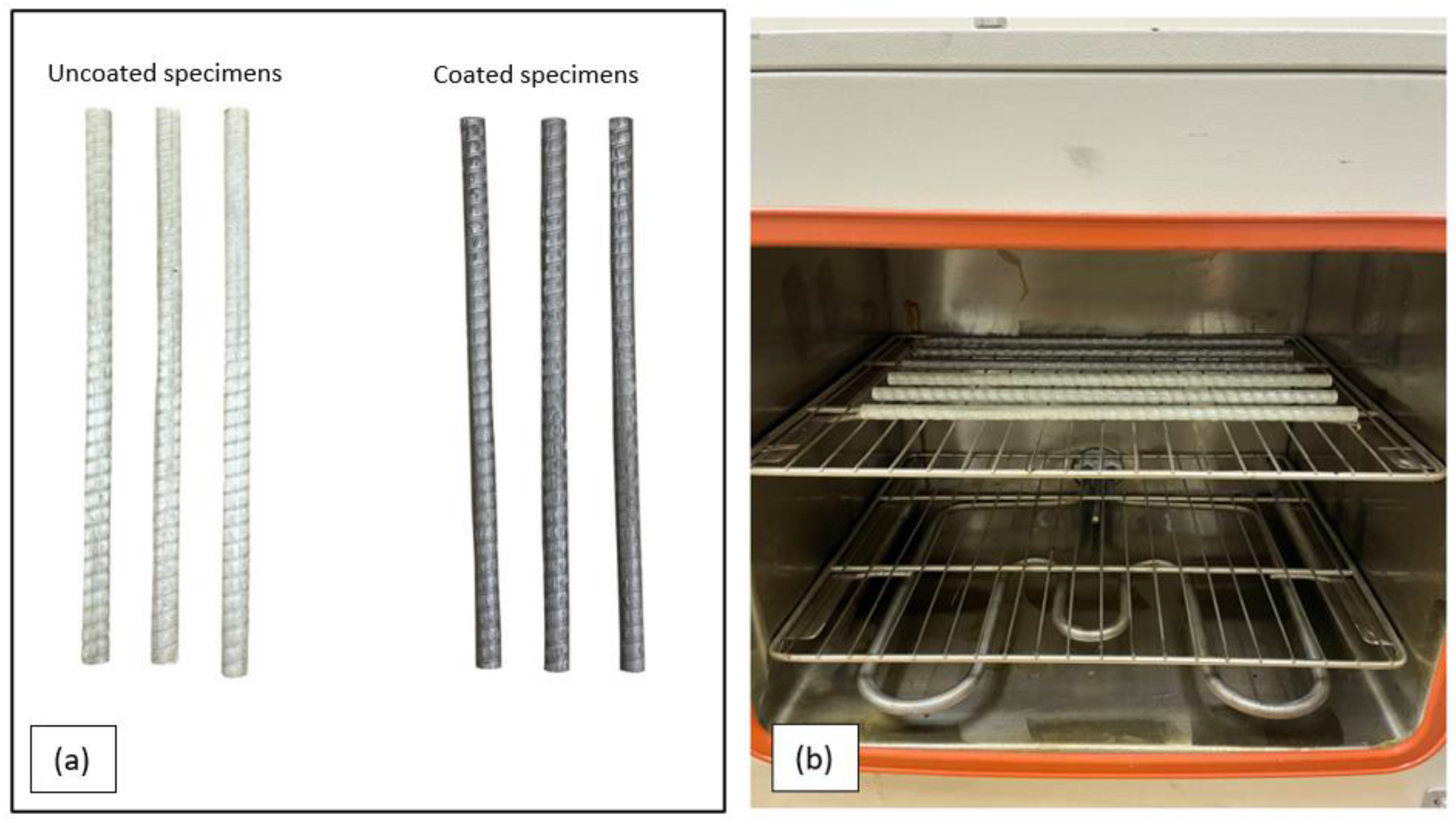
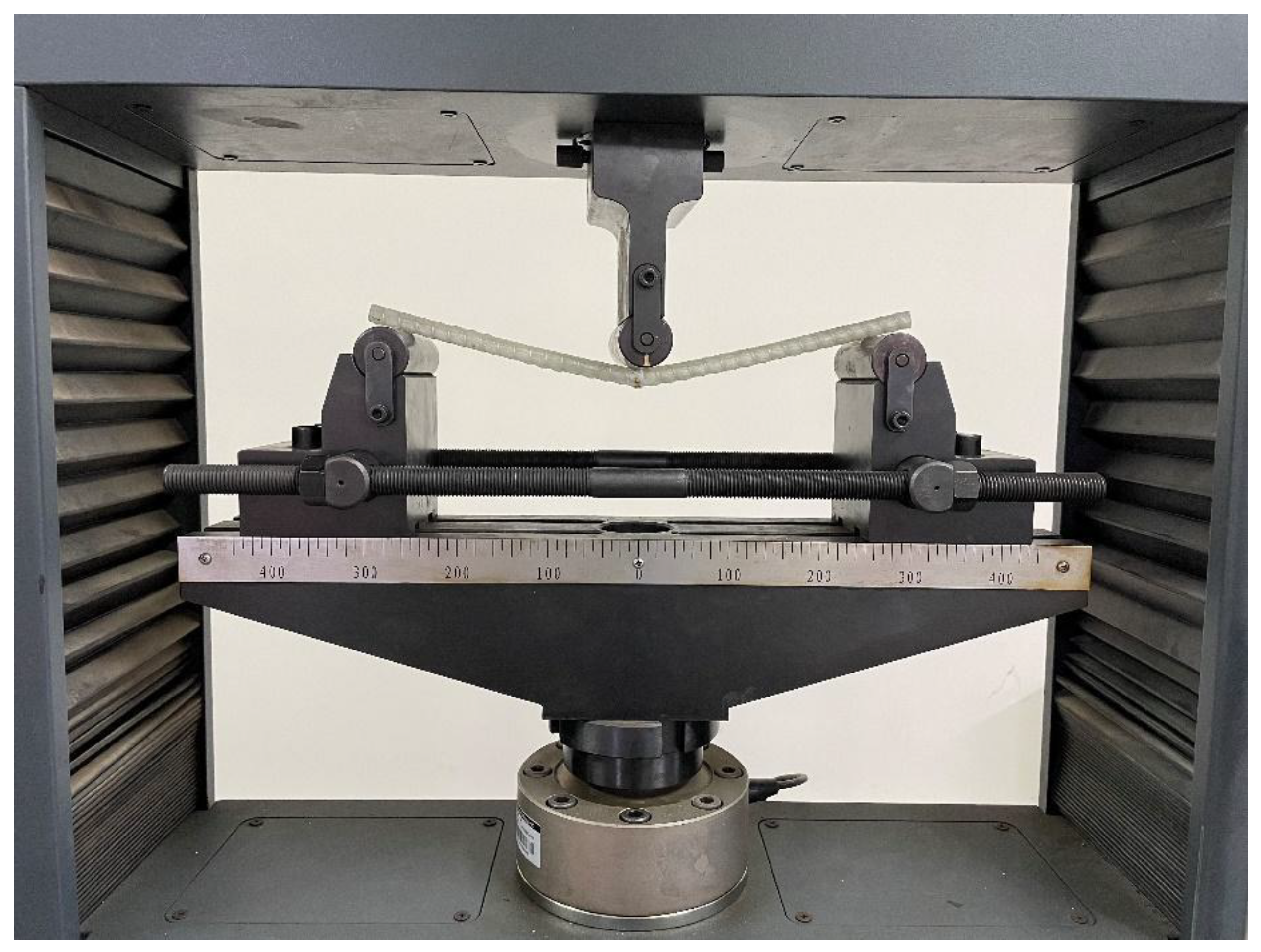
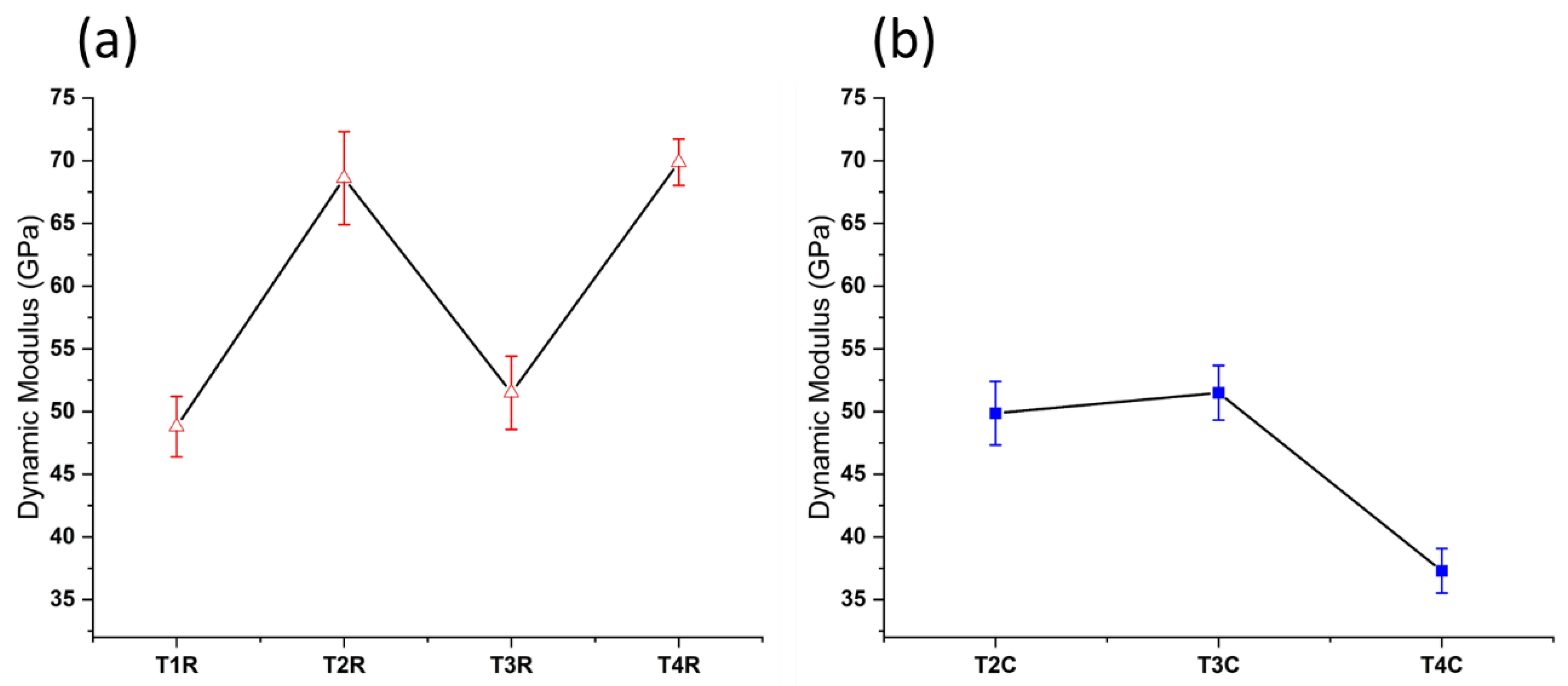


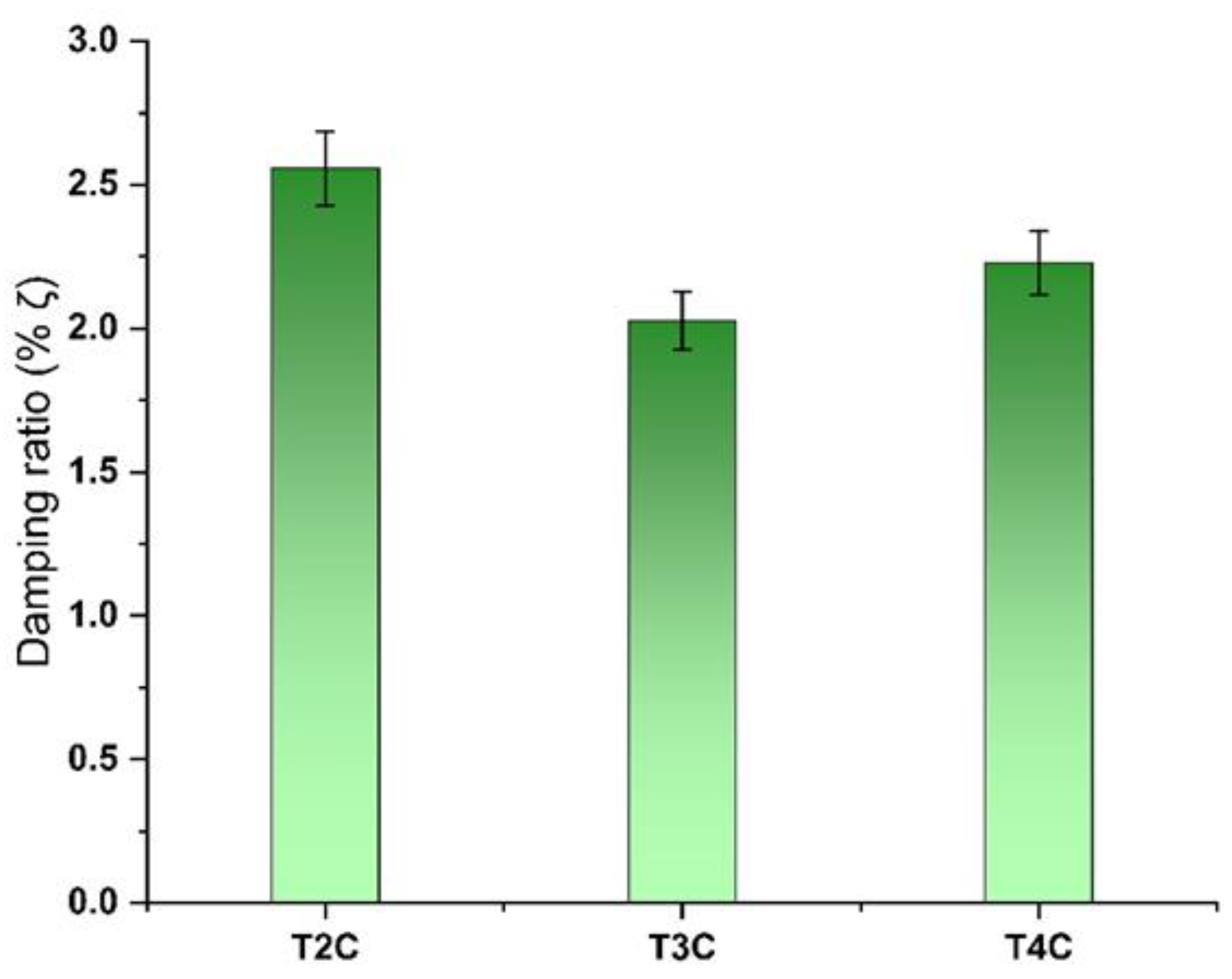
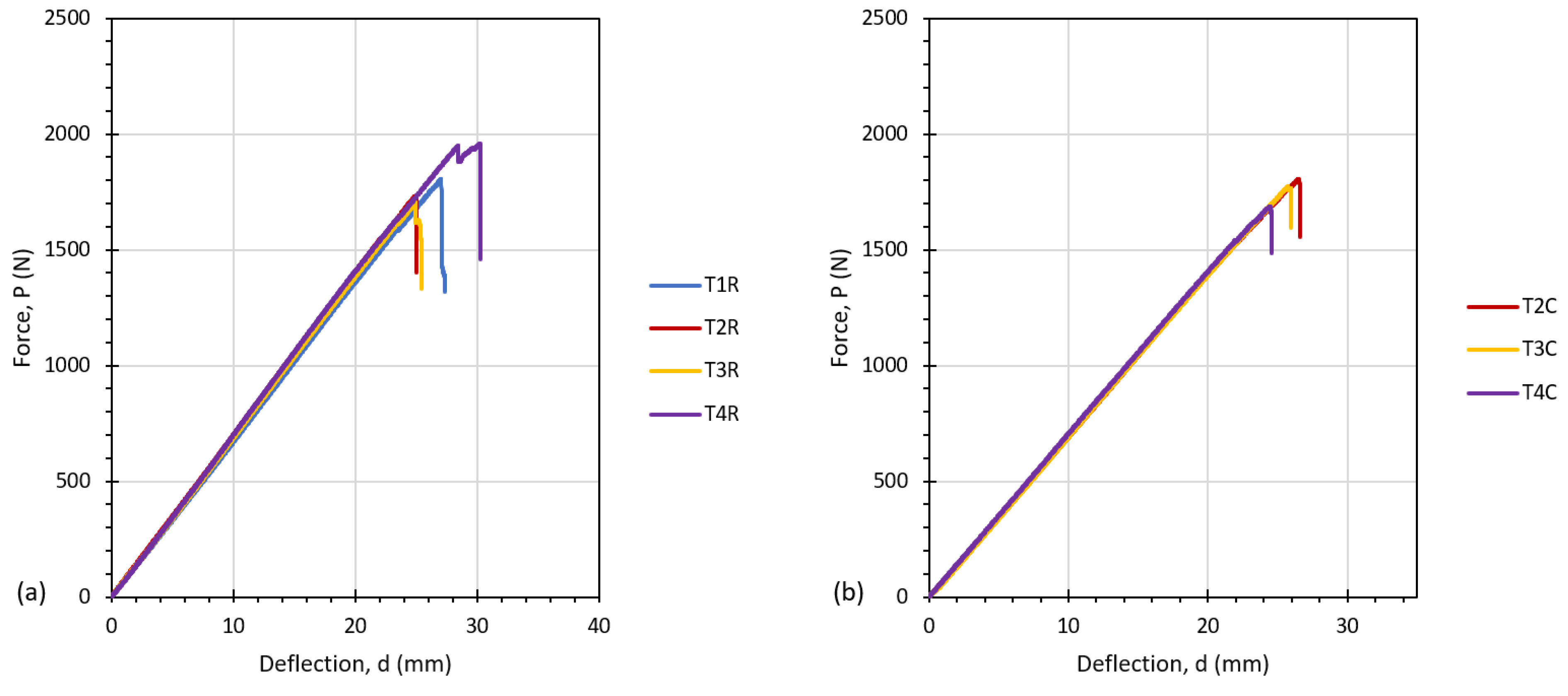
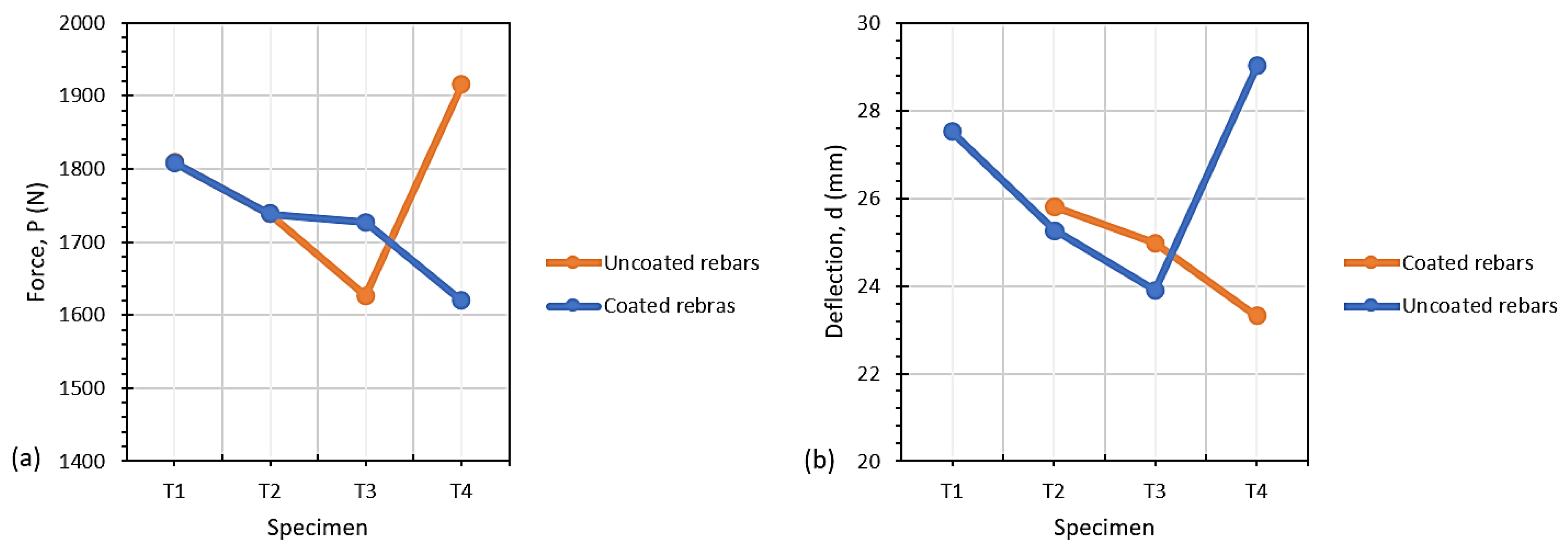
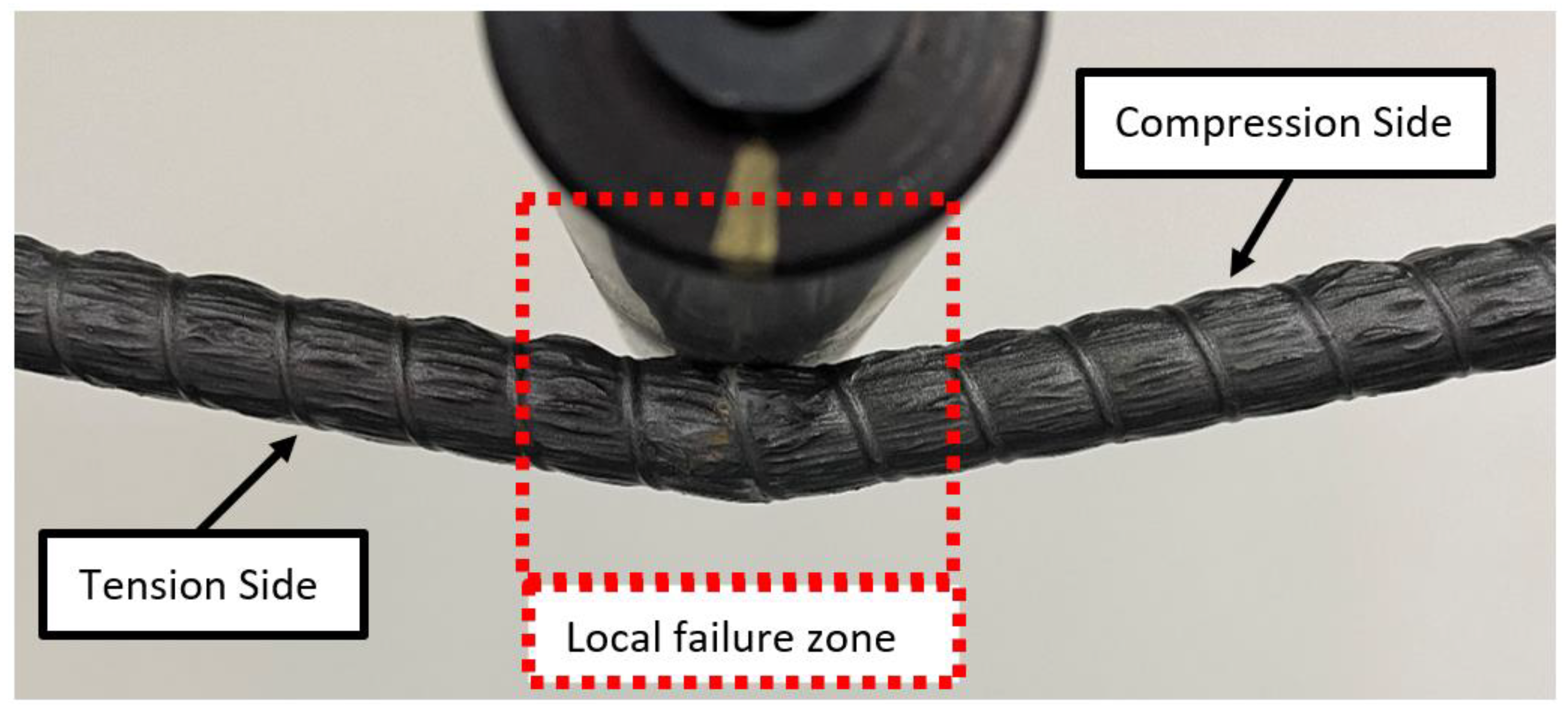

| GFRP Rebars Properties | |
|---|---|
| Diameter (mm) | 10 |
| Cross section (mm2) | 73 |
| Density (g/cm3) | 2.2 |
| Weight (g/m) | 150 |
| Ultimate tensile strength (MPa) | 980 |
| Ultimate shear strength (MPa) | >150 |
| Modulus of elasticity (GPa) | >40 |
| Fiber volume fraction (%) | 70 |
| Coating Material Properties | |
| Viscosity (cP) | 30 |
| Density (g/mL) | 1.36 |
| Coating Material Mixture | |
| p-chlorobenzotrifluoride (wt %) | 50–<75 |
| Ambient Cure Refractory Resin (wt %) | 25–<50 |
| Ceramic-Based Pigments and Additives (wt %) | 25–<50 |
| Performance Ceramic #1 (wt %) | 10–<25 |
| Carbon Black (wt %) | 1–<5 |
| Rheology Modifiers (wt %) | 1–<5 |
| Specimen Type | Specimen Number | Temp (°C) |
|---|---|---|
| Uncoated | T1R | 23 |
| T2R | 140 ± 7 | |
| T3R | 200 ± 7 | |
| T4R | 290 ± 7 | |
| Coated | T2C | 140 ± 7 |
| T3C | 200 ± 7 | |
| T4C | 290 ± 7 |
| Specimen | Resonant Frequency Fn (Hz) | Damping Ratio ζ% | Loss Factor η% | Dynamic Modulus E (GPa) |
|---|---|---|---|---|
| T1R | 183.35 ± 3.41 | 1.03 ± 0.31 | 2.06 | 48.79 ± 2.41 |
| T2R | 217.09 ± 1.89 | 1.81 ± 0.62 | 3.62 | 68.60 ± 3.71 |
| T3R | 188.97 ± 2.19 | 2.39 ± 0.32 | 4.78 | 51.49 ± 2.92 |
| T4R | 219.02 ± 2.85 | 2.73 ± 0.44 | 5.46 | 69.87 ± 1.85 |
| T2C | 185.18 ± 1.97 | 2.55 ± 0.31 | 5.11 | 49.86 ± 2.54 |
| T3C | 188.46 ± 2.65 | 2.02 ± 0.23 | 4.05 | 51.49 ± 2.18 |
| T4C | 160.82 ± 2.74 | 2.22 ± 0.13 | 4.45 | 37.29 ± 1.77 |
| Specimen | Pmax (N) | CV% | dmax (mm) | CV% |
|---|---|---|---|---|
| T1R | 1809 | ±0.3 | 27.5 | ±1.8 |
| T2R | 1737 | ±4.4 | 25.3 | ±5.1 |
| T3R | 1626 | ±4.8 | 23.9 | ±4.2 |
| T4R | 1915 | ±4.1 | 29.0 | ±5.9 |
| T2C | 1738 | ±6.4 | 25.8 | ±8.0 |
| T3C | 1727 | ±2.7 | 25.0 | ±3.1 |
| T4C | 1619 | ±4.0 | 23.3 | ±3.8 |
Publisher’s Note: MDPI stays neutral with regard to jurisdictional claims in published maps and institutional affiliations. |
© 2022 by the authors. Licensee MDPI, Basel, Switzerland. This article is an open access article distributed under the terms and conditions of the Creative Commons Attribution (CC BY) license (https://creativecommons.org/licenses/by/4.0/).
Share and Cite
Basha, M.; Moustafa, E.B.; Melaibari, A. The Dynamic and Flexural Behavior of Coated GFRP Rebars after Exposure to Elevated Temperatures. Coatings 2022, 12, 902. https://doi.org/10.3390/coatings12070902
Basha M, Moustafa EB, Melaibari A. The Dynamic and Flexural Behavior of Coated GFRP Rebars after Exposure to Elevated Temperatures. Coatings. 2022; 12(7):902. https://doi.org/10.3390/coatings12070902
Chicago/Turabian StyleBasha, Muhammad, Essam B. Moustafa, and Ammar Melaibari. 2022. "The Dynamic and Flexural Behavior of Coated GFRP Rebars after Exposure to Elevated Temperatures" Coatings 12, no. 7: 902. https://doi.org/10.3390/coatings12070902
APA StyleBasha, M., Moustafa, E. B., & Melaibari, A. (2022). The Dynamic and Flexural Behavior of Coated GFRP Rebars after Exposure to Elevated Temperatures. Coatings, 12(7), 902. https://doi.org/10.3390/coatings12070902






